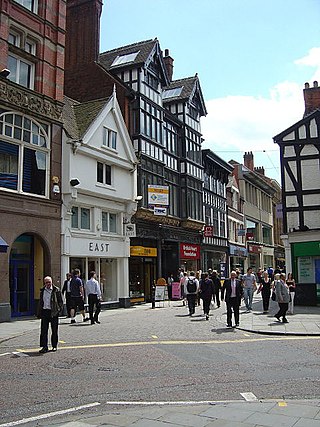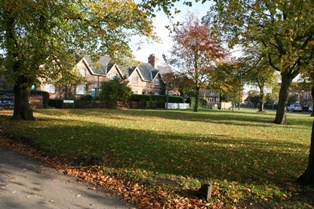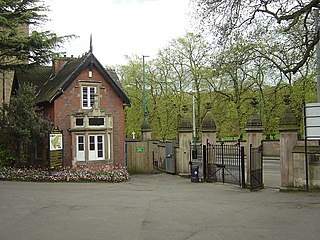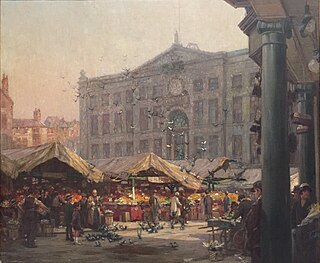
Edward Smith-Stanley, 12th Earl of Derby PC, usually styled Lord Stanley from 1771 to 1776, was a British peer and politician of the late eighteenth and early nineteenth centuries. He held office as Chancellor of the Duchy of Lancaster in 1783 in the Fox–North coalition and between 1806 and 1807 in the Ministry of All the Talents.

Bridlesmith Gate is a pedestrianised shopping street in the city centre of Nottingham, England. It is located between Middle Pavement and Victoria Street. St. Peter's Gate and Bottle Lane stem off it along with Byard Lane.

Mansfield railway station serves the town of Mansfield in Nottinghamshire, England. It was also known as Mansfield Town, to distinguish itself from the GCR's former Mansfield Central and Mansfield Woodhouse stations. It is a stop on the Robin Hood Line, located 17 miles (27 km) north of Nottingham; it is managed by East Midlands Railway. The station building is Grade II listed.

Flintham is a village and civil parish in the Rushcliffe district in Nottinghamshire, 7 miles from Newark-on-Trent and opposite RAF Syerston on the A46. It had a population of 597 at the 2011 census, estimated at 586 in 2019, and a fall to 563 at the 2021 census. The village name was taken by the Ham class minesweeper HMS Flintham.

Wilford is a village and former civil parish in the Nottingham district, in the ceremonial county of Nottinghamshire, England. The village is to the northeast of Clifton, southwest of West Bridgford, northwest of Ruddington and southwest of Nottingham city centre. It is at a meander of the River Trent.
Thomas Cecil Howitt, OBE was a British provincial architect of the 20th Century. Howitt is chiefly remembered for designing prominent public buildings, such as the Council House and Processional Way in Nottingham, Baskerville House in Birmingham, Newport Civic Centre, and several Odeon cinemas. Howitt's chief architectural legacies are in his home city of Nottingham. He was Housing Architect for the City Council, designing municipal housing estates which are often considered to be among the finest in terms of planning in the country.

St Peter's Church, formally The Church of St Peter with St James, is an Anglican parish church in the city centre of Nottingham, England. It is part of the parish of All Saints', St Mary's and St Peter's, Nottingham.

The Smith, later Bromley, later Pauncefote-Bromley, later Bromley-Wilson, later Bromley Baronetcy, of East Stoke in the County of Nottingham, is a title in the Baronetage of Great Britain. It was created on 31 October 1757 for the banker George Smith, High Sheriff of Nottinghamshire from 1757 to 1759. He was the eldest son of Abel Smith I (1686–1756) of Nottingham, the 2nd son of Thomas Smith I (1631–1699), the founder of Smith's Bank in Nottingham. His younger brothers included: Abel Smith II (1717–1788) and John Smith, ancestor of Julian Pauncefote, 1st Baron Pauncefote.
Richard Charles Sutton was an architect based in Nottingham. He was born 1834 and died on 18 October 1915.

Henry Moses Wood was an architect based in Nottingham.

All Saints' Church, Winthorpe is a Grade II listed parish church in the Church of England in Winthorpe, Nottinghamshire, England. The current building, the construction of which was completed in 1888, is at least the third version of the church, which dates back to at least the early 13th century. All Saints' Church was commissioned by the church rector, Edward Handley, in memory of one of his relatives.

Nottingham Exchange was built in the Market Place in Nottingham between 1724 and 1726 as the main offices of the Nottingham Corporation.
The following is a timeline of the history of the city of Nottingham, England.

Samuel Dutton Walker F.S.A. was an architect based in Nottingham.

John Howitt FRIBA was an architect based in Nottingham.

The Smith family is an English aristocratic and banking family founded by Thomas Smith (1631–1699), the founder of Smith's Bank of Nottingham. Its members include the Marquess of Lincolnshire (extinct), the Viscount Wendover (extinct), the Barons Carrington, the Baron Pauncefote (extinct), the Barons Bicester, the Bromley baronets and many Members of Parliament. Originally named Smith, the branch of the Barons Carrington assumed the surname Carington, the branch of the Bromley baronets the surname Bromley and the branch of the Baron Pauncefote the surname Pauncefote.

Robert Clarke was an architect based in Nottingham.

Thomas Simpson was an English architect based in Nottingham.

Sir George Smith, 1st Baronet (1714–1769) of Smith House, Angel Row, Nottingham and of Stoke Hall in the parish of East Stoke in Nottinghamshire, was a member of the Smith family of bankers, who established Smith's Bank in Nottingham in 1658. He was created a baronet "of East Stoke in the County of Nottingham", a title in the Baronetage of Great Britain, on 31 October 1757.
Rosalys Coope (1921-2018) was a much respected architectural historian. As well as an academic and researcher she served in the Women's Royal Naval Service during World War II.


















